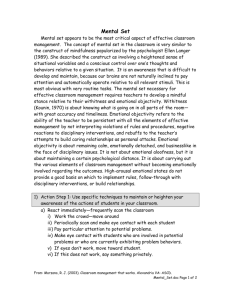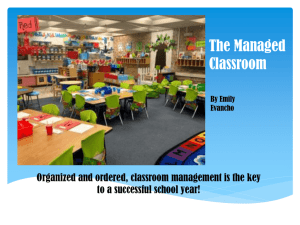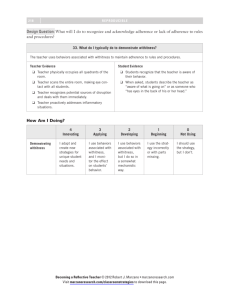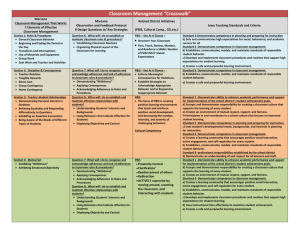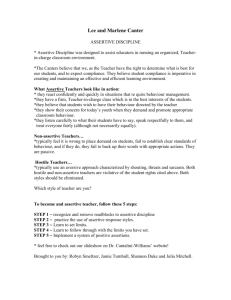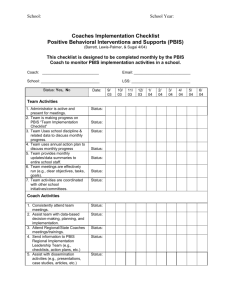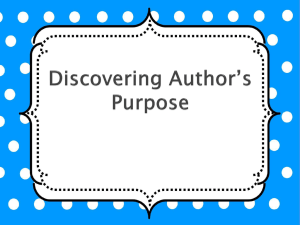classroom management teacher-student relationships mental set
advertisement
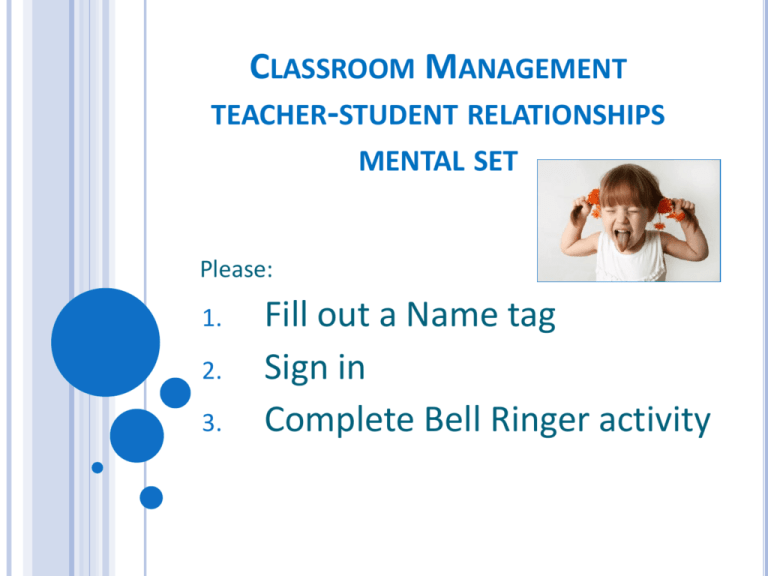
CLASSROOM MANAGEMENT TEACHER-STUDENT RELATIONSHIPS MENTAL SET Please: 1. 2. 3. Fill out a Name tag Sign in Complete Bell Ringer activity TEACHER-STUDENT RELATIONSHIPS MENTAL SET Consequences Discipline Mental Set Procedures Rules Relationships GOALS Participants will develop a better understanding of key ideas involved in student/teacher relationships. Participants will develop an understanding of mental set and how it relates to the work of a teacher. 4 GROUND RULES Take responsibility for your own learning. Participate. Ask questions. Listen to learn. Respect participants and presenter. Honor time limits. Silence cell phones (includes texting) 5 PARKING LOT What “hooks” do you use? What is the importance of developing effective relationships with students? WORLDLY LEARNING PARTNERS TEACHER-STUDENT RELATIONSHIPS Marzano Classroom Management That Works 7 Elements of Effective Classroom Management Section 3: Teacher-Student Relationships Demonstrating Personal Interest in Students Behaving Equitably and Responding Affirmatively to Questions Exhibiting an Assertive Connection Being Aware of the Needs of Different Types of Students Marzano Observation and Feedback Protocol 9 Design Questions w/ Key Strategies Related District Initiatives (PBiS, Cultural Comp., CEI,etc.) Question 8: What will I do to PBIS establish and maintain The focus of PBIS effective relationships with is creating students? positive learning Understanding Students’ environments Interests and that teach and Backgrounds reinforce positive Using Behaviors that social Indicate Affection for development, Students and decreasing Displaying Objectivity and the number, Control intensity, and severity of challenging behaviors. Cultural Competency Iowa Teaching Standards and Criteria Standard 1 -Demonstrates ability to enhance academic performance and support for implementation of the school district’s student achievement goals. d) Accepts and demonstrates responsibility for creating a classroom culture that supports the learning of every student. e) Creates an environment of mutual respect, rapport, and fairness. f) Participates in and contributes to a school culture that focuses on improved student learning. Standard 3 -Demonstrates competence in planning and preparing for instruction. c) Uses student’s developmental needs, backgrounds, and interests in planning for instruction. Standard 6 Demonstrates competence in classroom management. a) Creates a learning community that encourages positive social interaction, active engagement, and self-regulation for every student. b) Establishes, communicates, models, and maintains standards of responsible student behavior. Standard 8 -professional responsibilities established by the school district d) Demonstrates an understanding of and respect for all learners and staff. Marzano Classroom Management That Works 7 Elements of Effective Classroom Management Marzano Observation and Feedback Protocol 9 Design Questions w/ Key Strategies Section 4: Mental Set Exhibiting “Withitness” Exhibiting Emotional Objectivity Question 7: What will I do to recognize and acknowledge adherence and lack of adherence to classroom rules & procedures? Demonstrating “Withitness” Applying Consequences Acknowledging Adherence to Rules and Procedures Question 8: What will I do to establish and maintain effective relationships with students? Understanding Students’ Interests and Backgrounds Using Behaviors that Indicate Affection for Students Displaying Objectivity and Control Related District Initiatives (PBiS, Cultural Comp., CEI,etc.) PBIS Proximity Control Clarification’ Reinforcement of others Redirection ACTIVELY supervise by moving around, scanning the classroom, and interacting with students Iowa Teaching Standards and Criteria Standard 1 -Demonstrates ability to enhance academic performance and support for implementation of the school district’s student achievement goals. d) Accepts and demonstrates responsibility for creating a classroom culture that supports the learning of every student. e) Creates an environment of mutual respect, rapport, and fairness. Standard 6 -Demonstrates competence in classroom management. a) Creates a learning community that encourages positive social interaction, active engagement, and self-regulation for every student. b) Establishes, communicates, models, and maintains standards of responsible student behavior. c) Develops and implements classroom procedures and routines that support high expectations for student learning. d) Uses instructional time effectively to maximize student achievement. e) Creates a safe and purposeful learning environment. STUDENT TEACHER RELATIONSHIPS The starting point for classroom management Not a function of what teachers feel, but a function of what teachers do! Good News! Teachers can have a positive relationship with every student regardless of how the teacher feels about the students in a class TEACHER- STUDENT RELATIONSHIPS Demonstrating Personal Interest in Students Behaving Equitably and Responding Affirmatively to Questions Exhibiting an Assertive Connection Being Aware of the Needs of Different Types of Students TEACHER- STUDENT RELATIONSHIPS 1. Discovering and incorporating students’ personal interests into academics 2. Noticing individual accomplishments and important events in student’s lives. 3. Interacting with students as individuals Demonstrating Personal Interest in Students HUMOR Engage in playful banter with students when appropriate Keep a book of jokes or cartoons handy and read something funny at the beginning of class Laugh Laugh at yourself with your students Play on words STUDENTS CAN REFUSE WORDS, BUT THEY CANNOT REFUSE AN INVITATIONAL ATTITUDE. Is my physical space inviting? Am I dressed for respect? (I am one of a group of professional, proud, devoted, dedicated, responsible, and appreciated people.) Do my behaviors indicate an inviting person? (Smile, manners, affection) TEACHER- STUDENT RELATIONSHIPS Behaving Equitably and Responding Affirmatively to Questions 1. Physical Gestures and Movements 2. Positive Interaction Strategies 3. Affirmative Reactions to Incorrect Responses TEACHER- STUDENT RELATIONSHIPS Exhibiting an Assertive Connector 1. Assertive Connector 2. Apathetic Avoider 3. Junior Therapist 4. Bulldozer 5. Hider REFLECTION ON COMMUNICATION STYLE What is my dominant communication style? How does this effect my interaction with students? An action I will take to work on being an Assertive Connector. EDUCATORS VS. BULLIES What do you want to be known as? TEACHER- STUDENT RELATIONSHIPS Being Aware of the Needs of Different Types of Students 1. Passive a. b. 2. Aggressive a. b. c. 3. b. 5. Hostile Oppositional Covert Attention Problems a. 4. Fear of relationships Fear of failure Hyperactive Inattentive Perfectionist Socially Inept MENTAL SET The mental readiness a teacher brings to the management process. MENTAL SET Without appropriate Mental Set , NONE of the other aspects of classroom management work very well. MENTAL SET Deals with the way the teacher thinks/behaves in the classroom moment to moment. 1. 2. Exhibiting “Withitness” Exhibiting Emotional Objectivity WITHITNESS Effective Managers monitor classrooms regularly. their They are positioned so that they can see all students. They continuously scan the room to keep track of what is going on, no matter what else they are doing at the time. Good and Brophy 2003 WITHITNESS 1. Occupying the Entire Room 2. Noticing potential problems 3. Using a series of Graduated actions 4. Forecasting Problems EMOTIONAL OBJECTIVITY 1. 2. Recognize that you are an emotional being Monitoring your thoughts and emotions SO HOW DO YOU REALLY FEEL? 1. List a student in your current care who you would have to admit falls on the “negative” side of your “fondness scale” 2. What specific thoughts, judgments, and feelings are you having about him/her? 3. Is there something that happened in the past or someone that reminds you of the current situation? 4. How can you treat this student more equitably? EMOTIONAL OBJECTIVITY 1. 2. 3. 4. Recognize that you are an emotional being Monitoring your thoughts and emotions Reframing Maintaining a cool exterior CAN YOU HEAR YOUR STUDENTS? OR… are they too busy listening to YOU? EMOTIONAL OBJECTIVITY 1. 2. 3. 4. 5. 6. Recognize that you are an emotional being Monitoring your thoughts and emotions Reframing Maintaining a cool exterior Take care of yourself Preventing and recuperating from Burnout TAKING CARE OF YOURSELF MOST IMPORTANT Strategy for a HEALTHY frame of mind. START FRESH EACH DAY! Controlled breathing Guided Imagery Funny Movies and TV Shows Special Treats Maintain Healthy Sense of Humor What do YOU do? BURNOUT Depersonalization – feeling unreal, ungrounded, detached from oneself as if in a dream Reductions in personal accomplishment Emotional exhaustion; increased physical illness Quickness to anger; mood swings Increased “rigidity”; feeling overwhelmed Increased cynicism or negative self-talk Preoccupation with work Changes in behavior; such as increased alcohol or drug use STRATEGIES TO PREVENT BURNOUT Use positive self-talk Time for YOU Mild exercise Good nutrition Set realistic goals; work smarter instead of harder Create a laughter folder Be around positive people and avoid negative ones REMEMBER your purpose in teaching when you first started; recall the JOY and EXCITEMENT you had Time for YOU Set realistic goals; work EMOTIONALLY HEALTHY PEOPLE Get things done Get along with others Contribute to lives of others Confident At ease with who they are Create few problems Able to resolve problems quickly/effectively Communication clear/assertive is MENTAL HEALTH SCALE 1. YOU 2. Parents/Siblings 3. HOME Life 4. SCHOOL Environment 5. FRIENDS Now What? GOALS Participants will develop a better understanding of key ideas involved in student/teacher relationships. Participants will develop an understanding of mental set and how it relates to the work of a teacher. CLASSROOM MANAGEMENT TEACHER-STUDENT RELATIONSHIPS MENTAL SET Complete- 39 Thinking Takes Shape Thank You Resources Each other Books On-line Coaches Administrators
